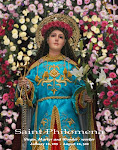
"Psallite Domino, qui ascendit super caelos caelorum as Orientem, alleluia." (Ps. LXVII. 33, 34)
Sing ye to the Lord, who mounteth above the heaven of heavens to the East, alleluia.
The Communion Antiphon for the Feast of the Ascension of the Lord in the Extraordinary Form of the Roman Rite shows that the mystery of the Ascension has influenced the Catholic custom of facing the east at the liturgical prayer. In the Acts of the Apostles, the apostles are shown as looking up to heaven as the Lord was taken away from their sight by a cloud. Two men in white garments said to them: "Ye men of Galilee, why stand you looking up to heaven? This Jesus, who is taken up from you into heaven, shall so come as you have seen Him going into heaven." What did they mean by the words: "This Jesus...shall so come as you have seen Him going into heaven"? Were they merely referring to the manner by which Christ our Lord ascended into heaven? Is he to return in the same way? Or did they also mean that on His return, the Lord will come back in the same location where He ascended into heaven.
Apparently, early on in the life of the Church, the words of the two heavenly beings were understood as referring to both the manner and the location of the Lord's departure and future return. In his book "Turning Towards the Lord: Orientation in Liturgical Prayer," Fr. U.M. Lang spoke of the liturgical direction of Jewish prayer as related to their expectation of the coming of the Messiah: "...after the destruction of the Temple, the prevailing custom of turning towards Jerusalem for prayer was kept in the liturgy of the synagogue. Thus Jews have expressed their eschatological hope for the coming of the Messiah, the rebuilding of the Temple, and the gathering of God's people from the Diaspora. The direction of prayer was thus inseparably bound up with the messianic expectation of Israel."
The same author made reference to the work of Georg Kretschmar who saw "a connection between the development of the eastward direction of prayer among Christians and a local tradition of the primitive Church in Jerusalem. Interpreting some Old Testament prophecies (Ezek 11:23; 43:1-2, 44:1-2, and Zech 14:4), the earliest Christians expected the Second Comingh of the Lord to be on the Mount of Olives, which was revered as the place of his Ascension (Acts 1:9-12). On the eve of the Passover, at any rate, the Christians of Jerusalem prayed turning toward s the Mount of Olives. Given the topography of the city, this meant that they were facing east."
Another scholar named Stefan Heid objected to Kretschmar's theory. However, even in his objection, he acknowledged the existence of a local tradition that the Second Coming was expected on the Mount of Olives: "...the sources for a local tradition that the Second Coming was expected on the Mount of Olives do not reach far back before AD 70."
Whether this local tradition was observed before or after AD 70, the fact remains that early on in the life of the Church, facing the orient during prayer ia already associated with the joyful expectation of the glorious coming of our Savior and Lord Jesus the Christ. The Church in Jerusalem faced the Mount of Olives, which was in the east. When we face the east during liturgical worship, we look at the place where He ascended into heaven. We look to that privileged place on earth where He left and where, we hope, He would return. The orientation of Catholic worship is a long standing tradition that looks back at the Ascension and looks forward to the Parousia.










No comments:
Post a Comment